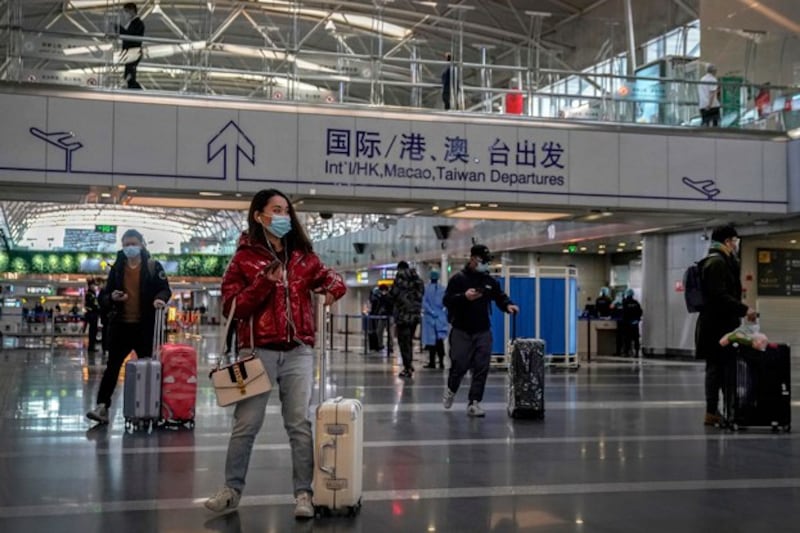Authorities in Taiwan have protested a "unilateral" change in flight paths starting Thursday that will bring civilian aircraft closer to the median line of the Taiwan Strait, which separates former civil war enemies the People's Republic of China and the 1911 Republic of China, which controls democratic Taiwan.
The island's Civil Aviation Administration said it "deeply regretted and strongly protested" a Jan. 30 announcement from the Civil Aviation Administration of China regarding the M503 flight route, which has sparked further concerns about flight safety and sovereignty in Taiwan, amid ongoing saber-rattling and incursions from Beijing.
"In 2015, China unilaterally declared the operation of M503 route, which is situated in the Shanghai Flight Information Region but very close to the Taipei Flight Information Region, prompting concerns about flight safety and sovereignty in Taiwan," the island's Central News Agency reported.
The route was later shifted further to the west -- closer to China and further away from the border with Taiwan's restricted airspace. Now, that concession is being canceled, Beijing says.
"China's new flight routes which are set to come into force on Feb. 1 not only disregard aviation safety and show disrespect for Taiwan, but also appear to be a deliberate attempt to use civil aviation as a cover for political, and possibly military intentions aimed at altering the status quo in the Taiwan Strait," the agency quoted Taiwan's Mainland Affairs Council as saying.
The fear is that China could take advantage of the route's proximity to the strait median line to launch a surprise air raid on Taiwan, although it is unlikely that such an attack could keep the element of surprise for long.
'No such thing' as median line
But experts told the agency that Chinese aircraft will now be flying just 7 kilometers (4 miles) from the median line on a daily basis, compared with 25 kilometers (16 miles) prior to the changes, making it harder for Taiwan to monitor the airspace close to the media line.
Chen Binhua, spokesman for China's Taiwan Affairs Office, rejected concerns, saying the move "conforms to the common interests of compatriots on both sides of the Taiwan Strait," and that it would reduce flight delays and ease pressure on regional air routes.
He said there was "no such thing" as the median line, because Taiwan is already an "inalienable" part of China's territory.

Taiwan's government has repeatedly rejected Beijing's territorial claim on the island, while the majority of the island's 23 million people identify as Taiwanese rather than Chinese.
Shen Mingshi, director of Taiwan's National Defense and Security Research Institute, said that the move rides roughshod over the symbolic meaning of the median line, which is seldom crossed by Chinese aircraft.
Taiwan's Democratic Progressive Party lawmaker Wang Ting-yu said the move could prove dangerous.
"When a country poses a military threat to Taiwan and has ambitions to annex it, when these routes are closer to Taiwan, that compromises flight safety and our ability to identify aircraft, putting pressure on ... response times," Wang said. "This is an extremely irresponsible move by China."
'A serious matter'
Taiwan’s Minister of Transportation Wang Kuo-tsai said there's a danger that aircraft flying a route that is just 4.2 nautical miles away from the median line could stray to the east in bad weather, potentially running into conflict with civilian or military aircraft.
"This is a very serious matter," Wang Kuo-tsai said. "The national security agency is now in charge of handling the response [to this announcement]."
Yu Tsung-kee, former dean of the School of Political Warfare at Taiwan's National Defense University said China changed the M503 route without authorization or coordination with Taiwan in advance.
"China's unauthorized changes are aimed at stepping up pressure on Taiwan's territory and international existence," Yu said. "Their aim is to force Taiwan to come to the negotiating table and accept 'unification' [under Chinese rule]."
Since Taiwanese voters elected Beijing's least favorite candidate Lai Ching-te as their next president last month, China has responded with growing pressure towards what it terms "peaceful unification," in a bid to bring the island under its control through propaganda, threats and infiltration rather than armed invasion.
China launched its diplomatic offensive just two days after the elections, with Taiwan's former diplomatic ally Nauru announcing it had switched diplomatic ties to Beijing.
Translated by Luisetta Mudie. Edited by Roseanne Gerin.
